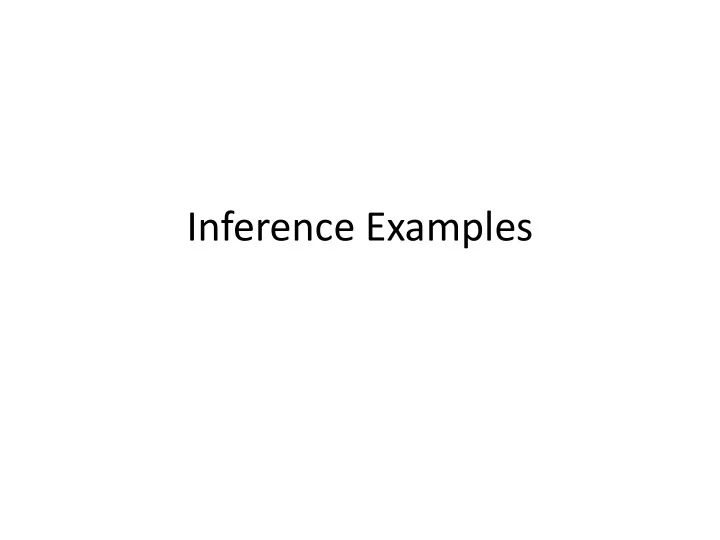

Inference Examples
Forward Chaining Rule 1: If on first floor Let us imagine that we start And button is pressed on first floor with the following facts in Then open door. our database: Rule 2: If on first floor Fact 1 And button is pressed on second floor On first floor Then go to second floor. Fact 2 Rule 3: If on first floor Button pressed on third floor And button is pressed on third floor Fact 3 Then go to third floor. Today is Tuesday Rule 4: If on second floor And button is pressed on first floor And already going to third floor Then remember to go to first floor later
Now the system examines the rules and finds that Facts 1 and 2 match the antecedents of Rule 3. Hence, Rule 3 fires, and its conclusion “Go to third floor” is added to the database of facts. Presumably, this results in the elevator heading toward the third floor. Note that Fact 3 was ignored altogether because it did not match the antecedents of any of the rules. Now let us imagine that the elevator is on its way to the third floor and has reached the second floor,when the button is pressed on the first floor. The fact “Button pressed on first floor” Is now added to the database, which results in Rule 4 firing.
Now let us imagine that later in the day the facts database contains the following information: Fact 1 At first floor Fact 2 Button pressed on second floor Fact 3 Button pressed on third floor In this case, two rules are triggered — Rules 2 and 3. In such cases where there is more than one possible conclusion, conflict resolution needs to be applied to decide which rule to fire.
CONFLICT RESOLUTION
CONFLICT RESOLUTION • Example: IF you’re bored AND you’ve no cash THEN go to a friend’s place. IF you’re bored AND You’ve no cash THEN go to a park.
CONFLICT RESOLUTION STRATEGIES • We have different resolution strategies: 1) Fire the first rule in sequence. 2) Assign rule priorities (by importance). 3) More specific rules are preferred over more general rules .(e.g. a rule having 5 IF’s(handle more info) will be preferred over one having 3 IF’s) 4) Prefer rules whose premises are added more recently (time stamping) 5) Parallel strategy (create view points)
EXAMPLE (Ben Coppin)
• An alternative method is the longest-matching strategy. This method involves firing the conclusion that was derived from the longest rule. • For example: IF patient has pain THEN prescribe painkiller IF patient has chest pain AND patient is over 60 AND patient has history of heart conditions THEN take to emergency room Here, if all the antecedents of the second rule match, then this rule’s conclusion should be fired rather than the conclusion of the first rule because it is a more specific match.
A further method for conflict resolution is to fire the rule that has matched the facts most recently added to the database. In each case, it may be that the system fires one rule and then stops (as in medical diagnosis), but in many cases, the system simply needs to choose a suitable ordering for the rules (as when controlling an elevator) because each rule that matches the facts needs to be fired at some point.
BACKWARD CHAINING
• Suppose we have been given the following facts, a) Sun is behind the clouds. b) Air is very heavy and cool. • Problem: Using Backward chaining try to conclude that there are chances of rain.
COMPARING FORWARD AND BACKWARD CHAINING BEN COPPIN
• Now let’s solve the same problem using resolution – First, convert to CNF – Negate the thing we are trying to prove and add it to the list – Resolve clauses to see if we can make the knowledge base unsatisfiable
• Either Heather attended the meeting or Heather was not invited. If the boss wanted Heather at the meeting, then she was invited. Heather did not attend the meeting. If the boss did not want Heather there, and the boss did not invite her there, then she is going to be fired. Use resolution to prove that Heather is going to be fired.
• If it rains, Joe brings his umbrella. • If Joe has an umbrella, he doesn’t get wet. • If it doesn’t rain, Joe doesn’t get wet. Prove by resolution that: Joe doesn’t get wet.
Recommend
More recommend